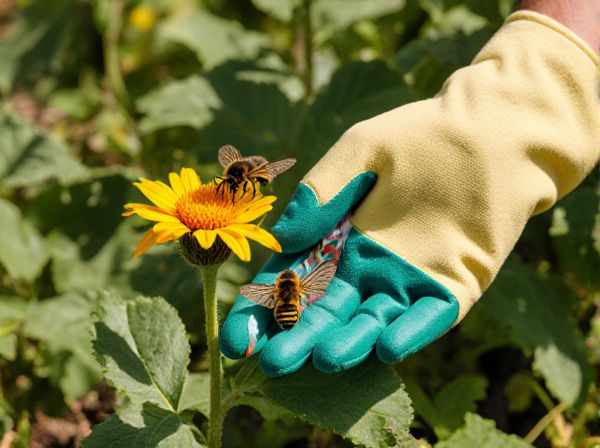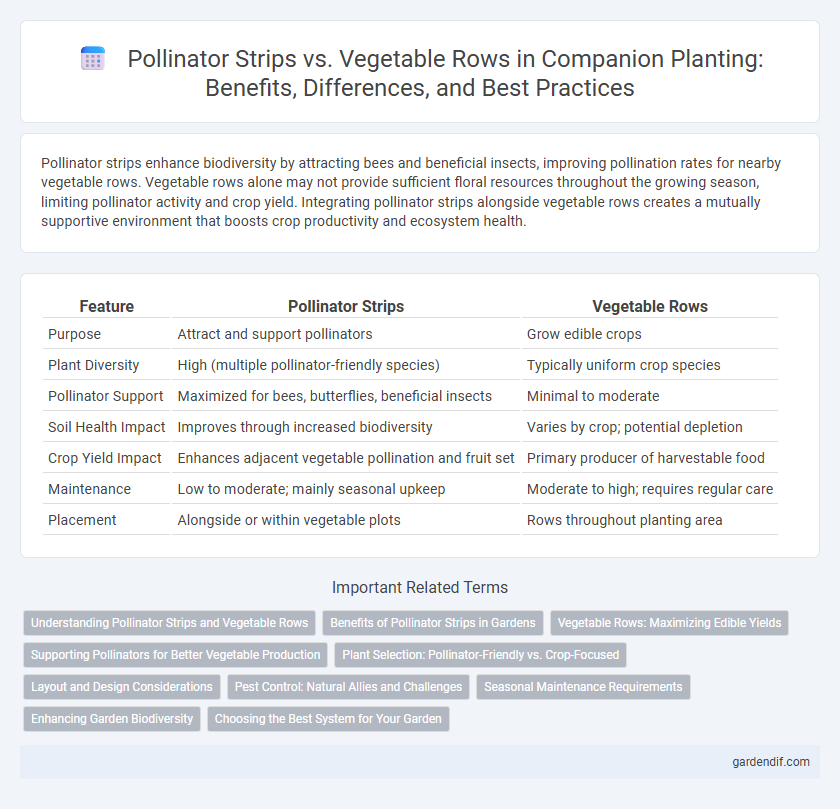
Pollinator strips vs vegetable rows Illustration
Pollinator strips enhance biodiversity by attracting bees and beneficial insects, improving pollination rates for nearby vegetable rows. Vegetable rows alone may not provide sufficient floral resources throughout the growing season, limiting pollinator activity and crop yield. Integrating pollinator strips alongside vegetable rows creates a mutually supportive environment that boosts crop productivity and ecosystem health.
Table of Comparison
| Feature | Pollinator Strips | Vegetable Rows |
|---|---|---|
| Purpose | Attract and support pollinators | Grow edible crops |
| Plant Diversity | High (multiple pollinator-friendly species) | Typically uniform crop species |
| Pollinator Support | Maximized for bees, butterflies, beneficial insects | Minimal to moderate |
| Soil Health Impact | Improves through increased biodiversity | Varies by crop; potential depletion |
| Crop Yield Impact | Enhances adjacent vegetable pollination and fruit set | Primary producer of harvestable food |
| Maintenance | Low to moderate; mainly seasonal upkeep | Moderate to high; requires regular care |
| Placement | Alongside or within vegetable plots | Rows throughout planting area |
Understanding Pollinator Strips and Vegetable Rows
Pollinator strips consist of densely planted flowering varieties that attract and support beneficial pollinators such as bees and butterflies, enhancing pollination efficiency in nearby crops. Vegetable rows are organized plantings of edible crops arranged for optimal growth and harvest but may lack the biodiversity needed to support pollinator populations effectively. Integrating pollinator strips alongside vegetable rows can improve crop yields by increasing pollinator activity and biodiversity within agricultural systems.
Benefits of Pollinator Strips in Gardens
Pollinator strips significantly enhance biodiversity by attracting bees, butterflies, and other beneficial insects that improve pollination rates in vegetable gardens. These strips increase crop yields and quality by facilitating effective pollen transfer, which supports healthier plant development and fruit production. Incorporating pollinator strips also contributes to natural pest control by encouraging predators that reduce harmful insect populations.
Vegetable Rows: Maximizing Edible Yields
Vegetable rows maximize edible yields by providing focused nutrient availability and optimal sunlight exposure tailored to each crop's needs, enhancing growth and harvest volumes. Companion planting within vegetable rows supports natural pest control and improves soil health, leading to higher quality produce without synthetic inputs. Strategic spacing and crop selection in vegetable rows also facilitate efficient pollination and water usage, boosting overall productivity and sustainability in home gardens and commercial farms.
Supporting Pollinators for Better Vegetable Production
Pollinator strips enhance vegetable production by providing essential habitat and diverse forage that attract and sustain a variety of pollinators such as bees, butterflies, and hoverflies. Compared to traditional vegetable rows, these strips increase pollinator visitation rates, leading to improved fruit set, yield, and quality in crops like tomatoes, cucumbers, and squash. Integrating pollinator strips into vegetable gardens supports ecosystem services, boosts biodiversity, and promotes sustainable agricultural practices.
Plant Selection: Pollinator-Friendly vs. Crop-Focused
Pollinator strips prioritize the selection of nectar-rich, native flowering plants designed to attract and sustain a variety of pollinators, enhancing biodiversity and ecosystem health. In contrast, vegetable rows focus primarily on crop selection aimed at maximizing yield and meeting dietary needs, often with fewer flowering plants that support pollinator populations. Balancing these plant selections promotes both effective pollination and productive harvests, creating a synergistic companion planting strategy.
Layout and Design Considerations
Pollinator strips positioned adjacent to vegetable rows optimize spatial efficiency by creating continuous habitats that enhance pollination services and reduce pest pressure. Designing a layout with alternating bands of diverse flowering plants alongside crops encourages beneficial insect movement and maximizes visual appeal while supporting ecosystem health. Strategic spacing and orientation ensure adequate sunlight and airflow, promoting both pollinator activity and vegetable growth.
Pest Control: Natural Allies and Challenges
Pollinator strips enhance pest control by attracting beneficial insects like ladybugs and lacewings, which prey on common vegetable pests such as aphids and caterpillars. Vegetable rows often lack the biodiversity needed to support these natural allies, making crops more vulnerable to infestations. However, pollinator strips may also harbor pests, requiring careful management to maximize their pest control benefits while minimizing challenges.
Seasonal Maintenance Requirements
Pollinator strips require periodic monitoring to ensure flowering plants bloom in succession, supporting pollinator presence throughout the growing season. Vegetable rows demand consistent care including watering, weeding, and pest control, with peak activity during planting and harvest periods. Seasonal maintenance of pollinator strips typically reduces pest pressures in adjacent vegetable rows, promoting ecological balance and crop health.
Enhancing Garden Biodiversity
Pollinator strips significantly enhance garden biodiversity by attracting a diverse range of beneficial insects, including bees, butterflies, and predatory wasps, which improve pollination and natural pest control. In contrast, vegetable rows alone often provide limited habitats and resources, reducing overall insect diversity. Integrating pollinator strips with vegetable planting creates a synergistic environment that supports ecosystem resilience and sustainable garden productivity.
Choosing the Best System for Your Garden
Pollinator strips enhance garden biodiversity by attracting essential pollinators such as bees and butterflies, boosting fruit and vegetable yields. Vegetable rows provide targeted growth environments, optimizing space and crop management for specific plants. Selecting the best system depends on garden size, desired biodiversity, and crop variety, balancing pollinator attraction with efficient plant production.
Pollinator strips vs vegetable rows Infographic

 gardendif.com
gardendif.com